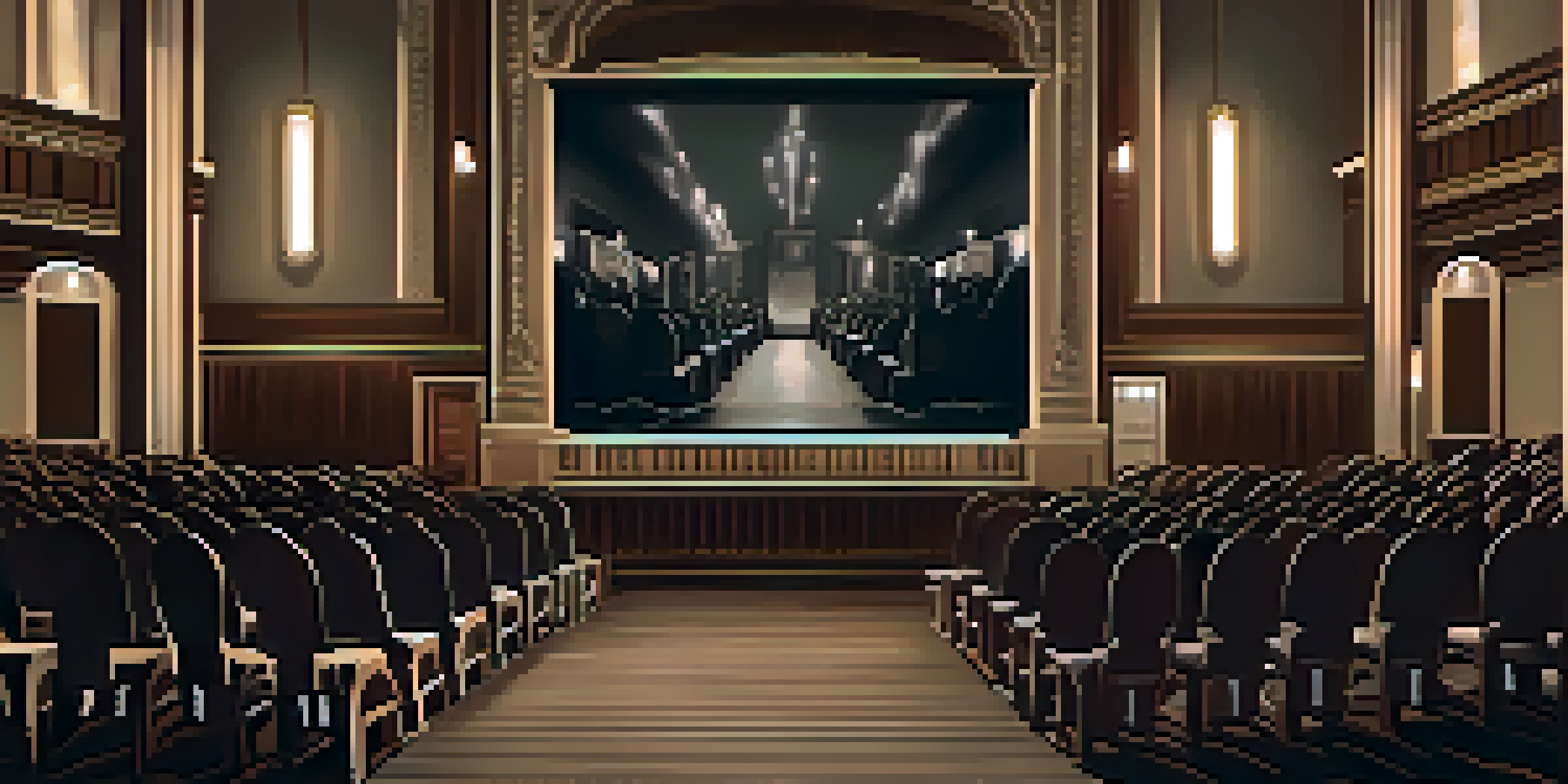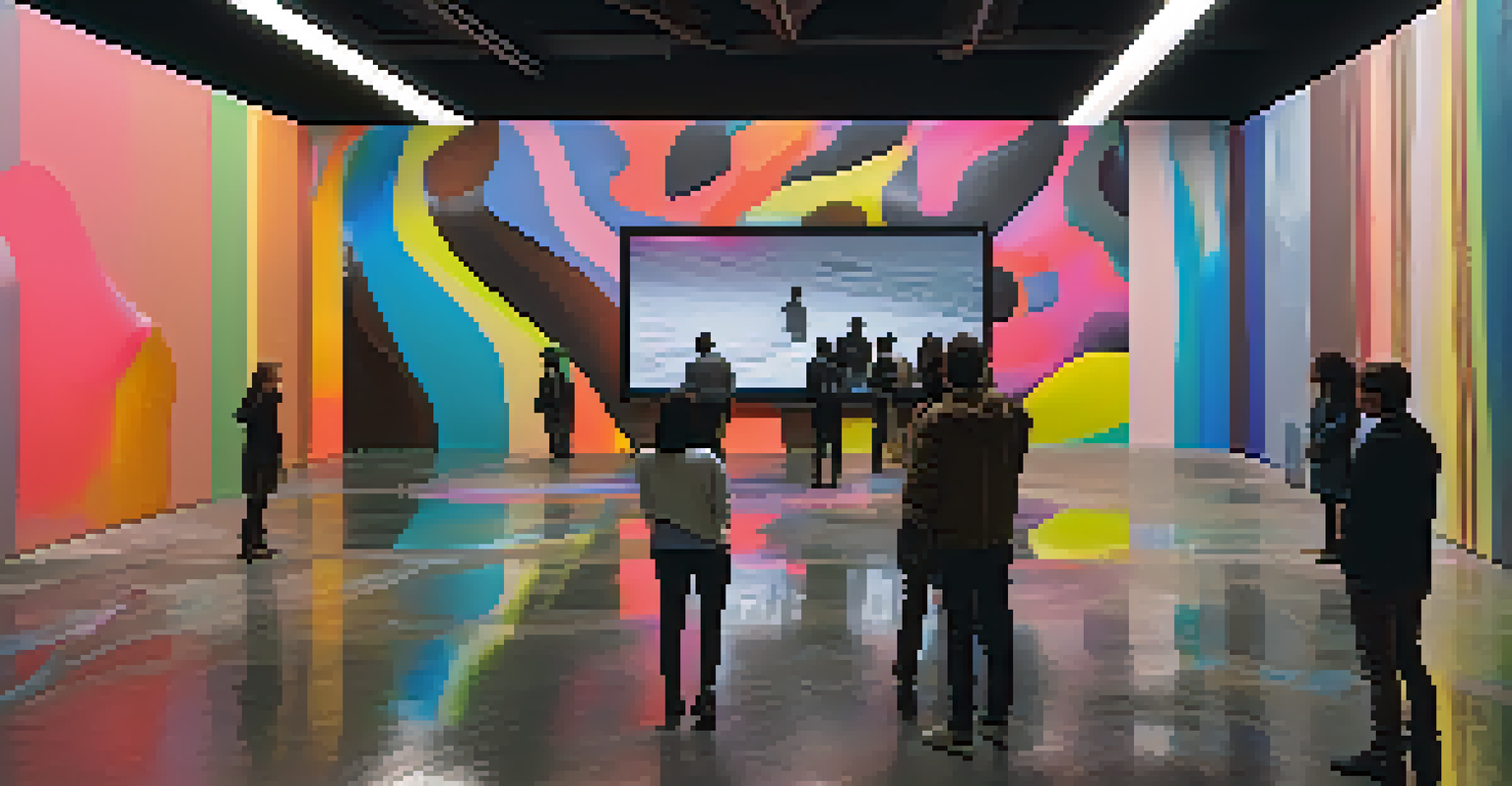The Evolution of Experimental Cinema Through the Decades

The Birth of Experimental Cinema in the 1920s
The 1920s marked a revolutionary period for cinema as filmmakers began to break away from traditional storytelling. Artists like Dziga Vertov and Sergei Eisenstein experimented with montage techniques, creating films that transcended mere narrative. This era was about exploration, where every frame was a canvas, and filmmakers pushed the boundaries of visual language.
Experimental cinema is not just about breaking rules; it is about redefining the very notion of what cinema can be.
Silent films like 'Man with a Movie Camera' showcased innovative editing and camera angles, providing a new lens through which audiences could experience reality. These early works laid the groundwork for what would later be recognized as experimental cinema, blending art and technology in unprecedented ways. This decade truly ignited a creative fire that would influence countless filmmakers.
Furthermore, the influence of art movements such as Surrealism and Dadaism seeped into cinema, encouraging artists to embrace absurdity and abstraction. The 1920s was not just an era of films; it was a cultural awakening that challenged perceptions of art, society, and the very nature of film itself.
The 1930s: The Rise of Avant-Garde Films
In the 1930s, avant-garde cinema began to take shape as filmmakers like Maya Deren and Luis Buñuel experimented with narrative structures and visual forms. Deren's 'Meshes of the Afternoon' introduced dreamlike sequences, blurring the line between reality and imagination. These films invited viewers to engage actively, interpreting meanings rather than passively consuming content.

This era also saw the emergence of sound, which added another layer of complexity to experimental films. Directors began to manipulate soundscapes, using audio to enhance the emotional impact of visuals, creating an immersive experience. The innovative use of sound in films like 'Un Chien Andalou' illustrated how audio could complement and challenge visual storytelling.
Technological Innovations Shape Film
Advancements in technology, from sound in the 1930s to digital tools in the 2000s, have significantly transformed the landscape of experimental cinema.
Moreover, the political climate of the 1930s influenced many filmmakers to use their art as a form of protest. They explored themes of identity, sexuality, and social justice, making experimental cinema a platform for voices often marginalized in mainstream film. This decade solidified the importance of cinema as a medium for social commentary.
The 1940s: Innovation Amidst War
The 1940s were marked by World War II, which significantly influenced the themes and styles of experimental cinema. Filmmakers like John Cage and Hans Richter utilized avant-garde techniques to comment on the absurdities of war and human existence. Their works often mirrored the chaos of the time, using disjointed narratives to evoke feelings of confusion and despair.
The camera is an instrument that teaches people how to see without a camera.
This decade also witnessed the birth of more abstract forms of cinema. The exploration of non-linear storytelling became prominent, allowing viewers to experience films in a fragmented way. Artists began to focus on the aesthetic qualities of film, emphasizing visual composition over traditional narratives, which would later inspire movements like Minimalism.
Furthermore, the post-war period sparked a desire for change and reflection, leading to films that explored existential themes. Filmmakers sought to capture the complexity of the human experience, often leaving audiences with more questions than answers. This era can be seen as a pivotal moment in the evolution of experimental cinema, laying the groundwork for future innovations.
The 1950s: The Birth of Structuralism
In the 1950s, structuralism emerged as a significant movement within experimental cinema. Filmmakers like Michael Snow and Hollis Frampton began to focus on the physicality of film itself, emphasizing the medium rather than conventional storytelling. Their works often explored the boundaries of film, asking viewers to reconsider what cinema could be.
This period also saw the rise of the 'film as film' philosophy, where directors intentionally stripped away narrative to highlight the mechanics of filmmaking. By emphasizing editing techniques and the passage of time, these films challenged audiences to engage with the medium on a deeper level. The idea was to provoke thought about the very nature of perception and reality.
Experimental Cinema's Evolution
From the 1920s to the present, experimental cinema has continuously evolved by challenging traditional narratives and embracing new technologies.
Moreover, the influence of the avant-garde continued to resonate, with many filmmakers borrowing elements from earlier movements. The 1950s showcased a rich tapestry of experimentation, with artists pushing the limits of cinematic form to explore complex themes of perception, identity, and existence.
The 1960s: The Counterculture and Radical Expression
The 1960s brought a wave of countercultural movements that greatly influenced experimental cinema. Filmmakers like Andy Warhol and Kenneth Anger embraced radical expression, creating films that often challenged societal norms. Warhol's 'Empire' and Anger's 'Scorpio Rising' pushed boundaries, mixing commercial and experimental aesthetics to provoke thought and discussion.
This decade was also characterized by the integration of political themes within experimental cinema. Filmmakers used their art as a platform to address issues like civil rights, feminism, and anti-war sentiments. This activism through film resonated with audiences, making cinema a vital tool for social change and awareness.
Additionally, the expansion of technology allowed for more experimentation with film techniques. The introduction of new formats and editing tools provided filmmakers with innovative ways to tell their stories. The result was a vibrant and diverse landscape of films that embraced experimentation, reflecting the tumultuous spirit of the time.
The 1970s: The Rise of Video Art
The 1970s marked a significant shift in experimental cinema with the advent of video technology. Artists like Nam June Paik and Bill Viola began to explore the possibilities of video as a medium, creating works that combined visual art with moving images. This shift opened up new avenues for expression, allowing artists to experiment with storytelling in ways that film could not.
Video's immediacy and accessibility democratized the art form, enabling more creators to share their visions with the world. As a result, a new generation of filmmakers emerged, using video to challenge established norms and explore personal narratives. This era was characterized by a blending of disciplines, with artists often crossing boundaries between film, performance, and visual art.
Art as Social Commentary
Filmmakers have utilized experimental cinema as a platform for social activism, addressing issues like identity, politics, and war throughout various decades.
Moreover, the 1970s saw the rise of installation art, where video was used to create immersive experiences. These installations invited audiences to engage with the artwork interactively, transforming the way cinema was experienced. The decade was a vibrant period of innovation, showcasing how experimental cinema could evolve alongside technological advancements.
The 1980s to 2000s: Digital Transformation
The late 20th century brought about a digital revolution that transformed experimental cinema. As technology advanced, filmmakers began to experiment with digital tools, creating works that challenged traditional notions of narrative and form. Digital editing, special effects, and computer-generated imagery (CGI) opened up endless possibilities for creative expression.
This period also saw the emergence of new genres, such as cyberpunk and interactive cinema, which reflected the changing landscape of society. Filmmakers like David Lynch and Lars von Trier embraced digital techniques to create thought-provoking narratives that pushed the boundaries of storytelling. These films often explored themes of identity, technology, and the human experience in a rapidly changing world.

Additionally, the accessibility of digital filmmaking encouraged a new wave of independent filmmakers to emerge. With lower production costs, more voices could be heard, leading to a diverse range of stories and perspectives. The digital transformation of experimental cinema not only expanded the medium but also democratized it, allowing for greater creativity and innovation.
The 2010s and Beyond: A New Era of Experimentation
Entering the 2010s, experimental cinema continued to evolve, embracing new technologies such as virtual reality and augmented reality. Filmmakers began to explore immersive storytelling experiences that blurred the lines between reality and fiction. This new frontier invited audiences to engage in ways never before possible, transforming the viewer's role from passive observer to active participant.
Moreover, social media platforms and streaming services provided a platform for experimental filmmakers to reach global audiences. Creators could now share their work without the constraints of traditional distribution, leading to a surge of innovative projects. This accessibility encouraged a diverse range of voices and styles, enriching the landscape of experimental cinema.
Furthermore, contemporary experimental films often reflect pressing social issues, from climate change to identity politics. Filmmakers harness the power of the medium to spark conversations and inspire change, using their art as a vehicle for activism. As we move forward, the evolution of experimental cinema promises to be as dynamic and impactful as ever, continually challenging our perceptions of art and reality.